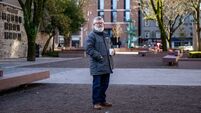Michael Moynihan: Isn't it about time that Cork became famous for 15 minutes?

Cork should examine the chance to put the idea of the fifteen-minute city into operation.
Feel free to shout aloud or slap down the paper if you’re suffering from opportunity fatigue.
As in, ‘the lockdown/virus is giving us an unparalleled opportunity to rethink . . .’ Depending on who you talk to, these opportunities cover everything from climate change to the reorganisation of music venues to physical development and a thousand points in between.
Some of these opportunities should be lauded for their ambition, though the weary cynic beneath this sunny, optimistic carapace (please — ed.) wonders how many of these opportunities will be taken up when the dust settles.
One opportunity which Cork should examine seriously, however, is the chance to put the idea of the 15-minute-city into operation.
It's simple enough: if you’re an urban dweller, then ideally all the services and facilities which you need should be within a 15-minute travel radius of where you live.
Let’s break that down without getting hung up on the ‘ideally’ part of the sentence.
It means you should be able to live, work, and socialise in your neighbourhood, a neighbourhood which should take 15 minutes to cross by foot or bike.
One of the principal movers behind the idea is Professor Carlos Moreno of the Sorbonne. His idea of ‘la ville du quart d’heure' is based on four general principles: proximity, diversity, density, and ubiquity.
The specifics? Moreno believes individual areas or neighbourhoods within a city should be able to fulfil six essential social functions for those living there: living, working, supplying, caring, enjoying, and learning.
Speaking to the recently, he said: “Living differently means above all transforming our relationship with time, especially time relating to moving around. Commuting is costly in every respect.
"There is no pleasure, no comfort in it.
"We need to break this rhythm of people’s lives, it is a radical approach that will transform lifestyles.”
Take the most obvious issue: there’s clearly quite a difference between the distance a person can cycle in 15 minutes compared to the distance that same person can walk.
You wouldn’t have to be Sam Bennett to cover three times the distance reached by the average walker but we needn’t get hung up on that: in that regard, it’s interesting that cities like Melbourne have adopted a 20-minute-city idea, perhaps as a compromise.
Granted, it might be more informative about this writer than anything else that such obstacles are the first thing that comes to mind, but take a look at the six necessities each neighbourhood must provide and apply them to your own situation.
Take living, working, supplying, caring, enjoying, and learning in turn.
Do you live near your workplace? Do you live 15 minutes from your workplace? Do you or your children attend a college or school that’s 15 minutes away from where you live? Do you socialise within that 15-minute zone around your living space? Can you get your groceries there? Can you see a doctor or a dentist in that zone?
Immediately there are challenges.
You may be happy with the work-home commute part, say, but the kids need to get to a music class held half an hour away. You may have to drive for an hour once a week to see a physio for a nagging back injury (free tip: sitting in the car for a two-hour round trip isn’t helping. No, I don’t do house calls.)
In this strict sense, the 15-minute-city idea is gone in 60 seconds, or however long you need to read the paragraph above. It gets consigned to the pile of pointy-headed aspirations that people come up with in ivory towers instead of living in the real world like the rest of us. Theory v practice, that’s the battlefield where there’s always only one winner.
Except that’s not at all fair to those pushing the idea in the first place.

Neither Moreno — nor the Melbourneites — are ruling out transport outside your particular neighbourhood. This applies specifically to work, which is pretty obviously the driver for those other five necessities.
Moreno, for instance, told the : “We don’t want to oblige people to stay in the 15-minute district,” while that outlet also reported Daisy Narayanan, an urbanist based in Edinburgh, as saying: “It’s not that everything needs to be within 20 minutes and you’re stuck within it, but it’s trying to ensure that people don’t hop in their car to get a pint of milk. That doesn’t limit you, it takes away some of the unnecessary journeys; it opens up a more accessible world.”
The temptation is always to look at such apparently radical recommendations for the urban experience as being too extreme for the quotidian, but as noted, the idea’s advocates have a more subtle goal in mind.
Making people think about the necessity of their journeys and the desirability of their destinations is far more manageable than some kind of draconian injunction to stay within your zone. It means you can sidestep the ominous overtones, for one thing.
But the notion serves another purpose as well. If you take your particular area of Cork — or whatever urban area you happen to be in — then a quick appraisal of the facilities within the 15-minute zone is illuminating.
How many essential services such as a hospital are within a quarter-hour of your front door? How many educational facilities? Is there a supermarket?
If the answer to those three questions is no, for instance, then there are broader questions worth raising. Never mind the suitability of the 15-minute model, should the basic suitability and accessibility of facilities and services be examined more closely?
A leisurely stroll around Cork city will reveal plenty of sectors without some of the essential six elements mentioned above.
An obvious example: how many parts of the northside of the city are within 15 minutes of a hospital, and by 15 minutes here I mean Steve McQueen in (or Ryan Gosling in , depending on your age)?
Clearly this is the starting point of a whole other column, but it’s interesting that it’s the 15-minute-city idea which brings the idea to the surface and forces one to evaluate other aspects of the city.
Take another tack: the sheer numbers of people working from home at present because of the virus are an obvious boost to the entire idea of the 15-minute-city. Working is, after all, one of the basic elements needed.
But it’s not clear how many of those people will troop willingly back to offices and shared workspaces when the virus eases. Nor is it clear how many of those offices or workspaces will reopen when and if, etc.
By getting people to change their attitudes the concept of the 15-minute-city has already done its work. Think of it as an opportunity open to all.











